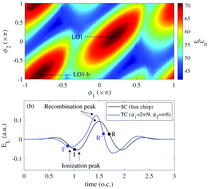Enhancing high harmonic generation by the global optimization of a two-color chirped laser field
Abstract
Enhanced high harmonics are generated by local and global optimization approaches to achieve a supercontinuum spectrum. Based on time-dependent density functional theory calculations, the optimum convolution of a two-color chirped pulse from an N2O molecule implements a significant enhancement of cutoff frequency and high harmonic yield. The optimization is done by controlling the effective chirp parameters and the carrier-envelope phase of the designed laser field. Indeed, all of the effective parameters are adjusted simultaneously for the global optimization; whereas, just two variables are tuned to obtain the desired cutoff frequency based on the local optimization. The results show that the global optimization approach extends the cutoff frequency by 96% compared to the single-color field, which could produce an isolated 25 as output pulse. This method opens up a valuable route by a pulse shaping mechanism for the control of high harmonic generation and ultrafast measurements for reducing the computational time and repeatability of an experiment with high accuracy.



 Please wait while we load your content...
Please wait while we load your content...